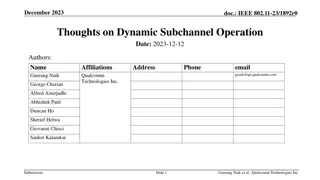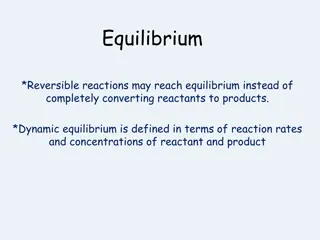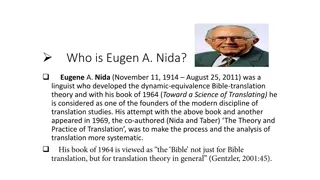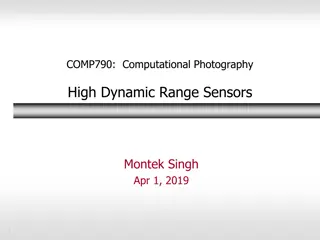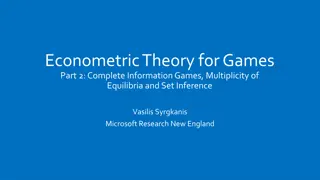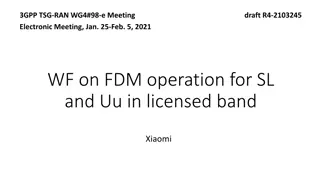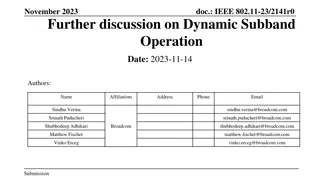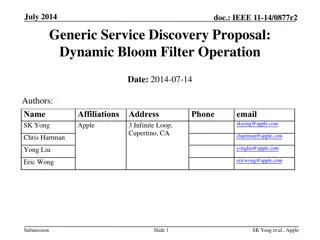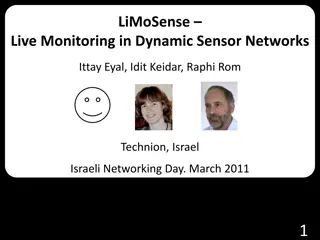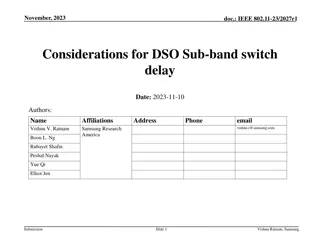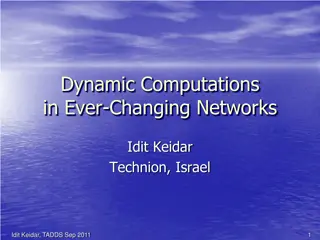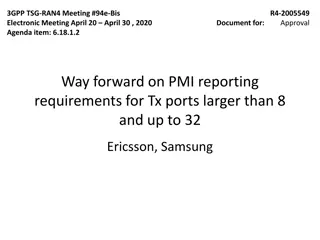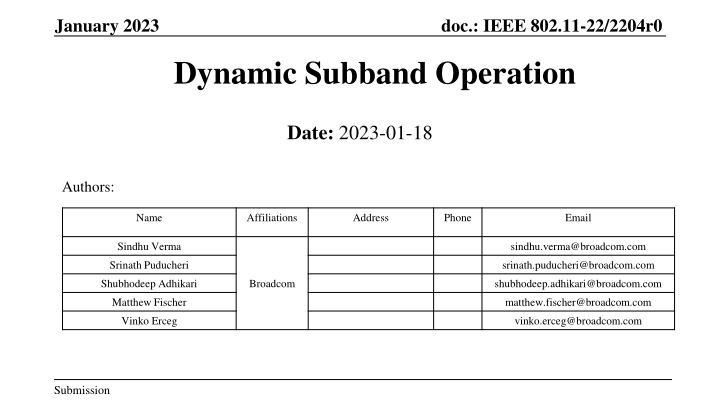
Dynamic Subband Operation in IEEE 802.11-22/2204r0 Standard
This document discusses the implementation of Dynamic Subband Operation in IEEE 802.11-22/2204r0 standard to address bandwidth mismatch issues between APs and non-APs. The proposed solution involves extending HE SST to enable non-APs to operate efficiently within varied bandwidth constraints, enhancing overall network performance.
Download Presentation

Please find below an Image/Link to download the presentation.
The content on the website is provided AS IS for your information and personal use only. It may not be sold, licensed, or shared on other websites without obtaining consent from the author. If you encounter any issues during the download, it is possible that the publisher has removed the file from their server.
You are allowed to download the files provided on this website for personal or commercial use, subject to the condition that they are used lawfully. All files are the property of their respective owners.
The content on the website is provided AS IS for your information and personal use only. It may not be sold, licensed, or shared on other websites without obtaining consent from the author.
E N D
Presentation Transcript
doc.: IEEE 802.11-22/2204r0 January 2023 Dynamic Subband Operation Date: 2023-01-18 Authors: Name Affiliations Address Phone Email Sindhu Verma sindhu.verma@broadcom.com Srinath Puducheri srinath.puducheri@broadcom.com Shubhodeep Adhikari Broadcom shubhodeep.adhikari@broadcom.com Matthew Fischer matthew.fischer@broadcom.com Vinko Erceg vinko.erceg@broadcom.com Submission
doc.: IEEE 802.11-22/2204r0 Overview Problem Statement Possible solution using extension of HE SST Limitations of the solution based on HE SST Alternate solution using Dynamic Subband Operation Proposal for Dynamic Subband Operation Performance gains Straw Polls Submission Slide 2
doc.: IEEE 802.11-22/2204r0 Problem Statement 802.11be supports 320MHz as the maximum bandwidth of operation on any one link. UHR may support even higher State of the art UHR APs are expected to support at least 320MHz bandwidth of operation However, many UHR non-APs may support only a smaller bandwidth (160MHz or lower) as the maximum bandwidth of operation. Such mismatch in the capabilities between the AP and the non-AP would result in wastage of bandwidth capabilities of the AP whenever the AP interacts with smaller bandwidth non-APs. Submission Slide 3
doc.: IEEE 802.11-22/2204r0 Possible solution using extension of HE SST HE SST (Subchannel Selective Transmission) allows an 80MHz non-AP to operate on the secondary 80MHz of a 160MHz operating bandwidth or a 20MHz non-AP to operate outside the primary 20MHz of a wider operating bandwidth. The operation is permitted during pre-negotiated TWT SPs of an individual TWT agreement and hence, follows a semi-static pattern. DL or trigger-based UL can occur inside the SPs Along similar lines, 802.11be/UHR may define an extension of HE SST allowing a non-AP to operate on the secondary 160MHz of a 320MHz operating bandwidth. Submission Slide 4
doc.: IEEE 802.11-22/2204r0 Limitations of the solution based on HE SST (1) There is no guarantee regarding the AP winning channel access on the secondary 160MHz channel during the predefined semi-static SPs. If this happens, the AP will not be able to schedule the non-APs that move to secondary 160MHz during the SP. This will happen even if the AP on winning the primary 160MHz during the same SP, has spare bandwidth within the primary 160MHz to allocate to these SST non-APs. This: Makes the AP scheduler limited and sub-optimal Wastes bandwidth resources The converse can also occur i.e. the AP may win access on the secondary 160MHz channel outside the semi-static SPs but cannot schedule any SST non-APs within it Even if the AP wins channel access on the secondary 160MHz channel during the SPs, there may not be any DL/UL buffered data for the SST non-APs during the SPs while data may arrive later outside of the SPs when all non-APs are present on the primary 160MHz Submission Slide 5
doc.: IEEE 802.11-22/2204r0 Limitations of the solution based on HE SST (2) If the AP intends to serve the SST non-APs outside the SST SPs, the following restrictions also apply (as corollaries from general individual TWT operation) It is recommended for the SST non-APs not to transmit anything to the AP outside these SST SPs The AP can transmit to the SST non-APs outside the SST SPs only if they are in active mode and not if they are in PS mode. Such a restriction risks the user experience Also, individual TWT negotiation is initiated by the non-AP and hence, cannot be enforced by the AP. HE SST has had very limited or no deployment and testing Submission Slide 6
doc.: IEEE 802.11-22/2204r0 Alternate solution using Dynamic Subband Operation UHR can define a new method Dynamic Subband Operation allowing the 320MHz AP to dynamically indicate to a 160MHz non-AP, Tx/Rx opportunity on the secondary 160MHz. While this presentation uses a 320MHz AP and a 160MHz non-AP as an illustration, the proposal is extensible to any AP/non-AP bandwidth combinations where the bandwidth supported by the AP is higher than the non-AP. The operation could be DL or trigger-based UL inside each dynamically allocated opportunity Dynamic Subband Operation can enable the AP to utilize its secondary 160MHz bandwidth in a dynamic manner on a per-TXOP basis whenever it wins channel access on it. The AP can dynamically decide whether to allocate non-APs on the primary 160MHz or secondary 160MHz and which non-APs to allocate in this manner depending on bandwidth availability, channel conditions and QoS requirements This helps align the presence of the narrower bandwidth non-APs on the secondary 160MHz channel with the availability of secondary 160MHz bandwidth This results in better resource utilization and system performance compared to HE SST. Slide 7 Submission
doc.: IEEE 802.11-22/2204r0 Proposal for Dynamic Subband Operation (1) We propose the following method to perform Dynamic Subband Operation (DSO) It involves the AP sending an indication to a DSO-capable non-AP at the beginning of any 320 MHz wide TXOP requiring the non-AP to transition to the secondary 160MHz for this TXOP and then continuing the frame exchange on the secondary 160MHz Following are the steps: The AP sends to the DSO non-AP being scheduled, a "subband-switch control frame", which is a special initial control frame (could be a modified MU-RTS or BSRP or a newly defined frame) that indicates transition to the secondary 160MHz The subband-switch control frame has sufficient padding to cover subband switch latency (i.e. latency required by the non-AP to switch from the primary 160MHz to secondary 160MHz) The subband switch latency depends on the non-AP implementation and is negotiated during the DSO capability signaling. Submission Slide 8
doc.: IEEE 802.11-22/2204r0 Proposal for Dynamic Subband Operation (2) Depending on the negotiated capabilities of the DSO-capable non-AP, the following options are possible: Option 1: The subband-switch initial control frame is used only for subband switch by DSO non- APs and does not elicit any response. SIFS later, the AP sends a second control frame (which can be a regular MU-RTS/BSRP) that elicits a response in the secondary 160MHz Option 2: The subband-switch initial control frame is used for subband switch by DSO non-APs and elicits a response in the secondary 160MHz The subband-switch initial control frame may be in non-HT duplicate format, again depending on the negotiated capabilities. Thereafter, the DSO TXOP can contain multiple SIFS-spaced DL/triggered UL exchanges with the DSO non-APs. At the end of the TXOP (for example, detected through a gap of SIFS+delta time), the DSO non-AP switches back to operating on the primary 160MHz. Submission Slide 9
doc.: IEEE 802.11-22/2204r0 Schematic diagram for Dynamic Subband Operation (Option 1) SIFS SIFS SIFS SIFS + delta Second control frame 160S Subband switch control frame (with padding for DSO) AP 160P Rx second control frame (on 160S) Tx 320 MHz DL/UL OFDMA Response (on 160S) 160S DSO STA Rx subband switch control frame (on 160P) Switch back to 160P 160P 160S non DSO STA Rx second control frame (on 160P) Tx Rx subband switch (on 160P) Response (on 160P) 160P 10 Submission
doc.: IEEE 802.11-22/2204r0 Performance Gains Dynamic Subband Operation allows a wider bandwidth AP to achieve a system performance equal to that supported by its wider bandwidth even when operating with non-APs that have narrower bandwidth. A 320MHz AP operating with 160MHz non-APs can achieve system performance of 320MHz with DSO and therefore, twice that achievable without DSO. The same holds for a 160MHz AP operating with 80MHz non-APs. AP/non-AP configurations with other bandwidth combinations can be supported in the same manner The DSO gains are proportional to the ratio of the bandwidth capability of the AP to that of the non-APs in case of PSD-limited scenarios (i.e. when power headroom is available). DSO gains in non-PSD-limited scenarios (i.e. when power headroom is not available), depend on the MCS being used. In most cases, a 3dB reduction in power being transmitted on one half of the bandwidth in order to transmit the same power on the other half will result in a drop in MCS by 1 level. The overheads associated with DSO, due to subband switch indication and latency amount to at most O(100) us. These overheads are negligible compared to the gains achievable with DSO, particularly when the TXOP spans a few ms. Submission Slide 11
doc.: IEEE 802.11-22/2204r0 Straw Poll 1 Do you agree to define Dynamic Subband Operation (DSO) in UHR where narrower bandwidth capable non-APs can dynamically on a per-TXOP basis, be allocated resources outside of their current operating bandwidth within the larger bandwidth of an AP? Y/N/A Submission Slide 12
doc.: IEEE 802.11-22/2204r0 Reference [1] IEEE P802.11be /D2.3 Submission Slide 13

